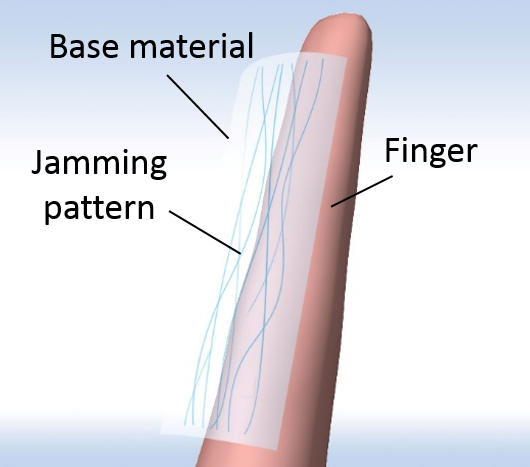News
News Release
Technique for Preventing Extraction of Finger Vein Patterns from Photographs
The research team of Professor Isao Echizen of the Information and Society Research Division of the National Institute of Informatics (NII; Chiyoda-ku, Tokyo; Dr. Masaru Kitsuregawa, Director General) has developed a technique for preventing the extraction of finger vein patterns as biological information from photographs. The proposed technique involves the wearing of a clear sticker on the finger. It can prevent unwanted extraction of biological information by preventing extraction of a finger vein pattern from a photograph while maintaining the convenience of finger vein authentication without having to remove the sticker.
Background
Finger vein authentication is a biological authentication technique that has become widely used for personal authentication at bank ATMs and elsewhere. Since finger veins lie beneath the skin, capturing them in visible light is difficult, and for this reason, finger-vein authentication equipment has come to use near-infrared light rays. However, a finger-vein authentication technique using images of multiple fingers captured in the visible region was proposed in 2016(*1), so it is now known that finger vein patterns can be extracted from visible-light images.
Research technique and results
The research team has developed a clear sticker imprinted with a "jamming pattern" as a fake finger vein pattern to interfere with the detection of actual finger veins from images captured with a commercially available digital camera (Fig. 1).

Fig. 1: Clear sticker preventing extraction of finger vein pattern
The commercial availability of high-pixel-count digital cameras in recent years has opened up the possibility of cracking finger-vein authentication systems through the use of finger vein patterns extracted from photographs. The need has therefore arisen for a means of preventing the extraction of finger vein patterns from photographs. Wearing gloves is one such means of preventing extraction from photographs, but having to take them off every time authentication is needed is hardly a practical solution. In contrast, this clear sticker satisfies the following three requirements taking practicality into account.
- Prevents extraction of finger vein patterns from photographs
- Enables finger vein authentication at installed equipment like ATMs while wearing the clear sticker
- Allows the user to easily attach or remove the sticker as desired and negates the need for upgrading authentication systems or equipment.
The prototype that we fabricated is a sticker imprinted with a fake finger vein pattern or "jamming pattern" on transparent base material that is permeable to both visible and near-infrared light rays. The jamming-pattern portion of this sticker reflects visible light while passing near-infrared light. Consequently, when photographing a finger wearing the clear sticker in visible light, a portion of the user's finger veins disappears due to the jamming pattern that becomes superimposed on the actual finger vein pattern in the captured image (Fig. 2 left). This prevents the finger vein pattern of a user wearing the sticker from being extracted from a photograph taken with a commercial digital camera. At the same time, the jamming pattern is invisible to equipment that reads finger vein patterns using near-infrared light, which means that such equipment can extract the finger vein patterns of a user wearing the clear sticker (Fig. 2 right).
Biological information such as finger vein patterns is said to be convenient for personal authentication since "it cannot be forgotten or lost." On the other hand, there is the problem that such biological information cannot be changed if it should be stolen by some means. This clear sticker, however, is difficult to notice, which means that the convenience of biological information can be improved to include "it cannot be stolen" without hindering daily life.
Fig. 2: Interference effect of jamming pattern in visible and near-infrared region
Future outlook
The results of this research show that the extraction of finger vein patterns from photographs can be prevented without affecting the practical use of finger vein authentication. Going forward, we plan to hold further tests on the effectiveness of this technique and to conduct studies on the application of this technique to various types of biological information. In this way, we aim to contribute to the development of safe and reliable biological authentication technologies in society.
Professor Isao Echizen makes the following comment: "Biological information used for personal identification or authentication includes iris and walking pattern (gait) in addition to face, voice, fingerprints, and veins. However, since biological information is lifetime invariant, care must be taken in its use. I hope to contribute to the establishment of technologies that can prevent the unwanted extraction or distribution of biological information making use of the characteristics of that information."
About this research project
This research was supported by Japan Society for the Promotion of Science (JSPS) Grants-in-Aid JP16H06302 and JP18H04120.
News Release: PDF
Technique for Preventing Extraction of Finger Vein Patterns from Photographs


 Summary of NII 2024
Summary of NII 2024 NII Today No.104(EN)
NII Today No.104(EN) NII Today No.103(EN)
NII Today No.103(EN) Overview of NII 2024
Overview of NII 2024 Guidance of Informatics Program, SOKENDAI 24-25
Guidance of Informatics Program, SOKENDAI 24-25 NII Today No.102(EN)
NII Today No.102(EN) SINETStream Use Case: Mobile Animal Laboratory [Bio-Innovation Research Center, Tokushima Univ.]
SINETStream Use Case: Mobile Animal Laboratory [Bio-Innovation Research Center, Tokushima Univ.] The National Institute of Information Basic Principles of Respect for LGBTQ
The National Institute of Information Basic Principles of Respect for LGBTQ DAAD
DAAD
